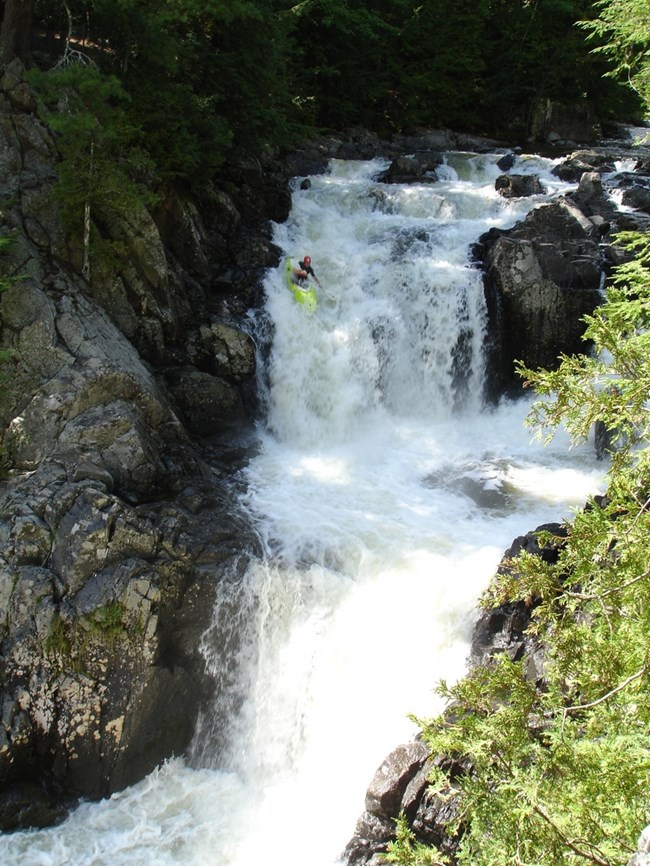
Boquet River, NY - American Whitewater/Justin Crannell
In order to be listed on the Nationwide Rivers Inventory (NRI), a river must be free-flowing and possess one or more 'outstandingly remarkable' natural and cultural values. The eligibility analysis consists of an examination of the river’s hydrology, including any human-made alterations, and an inventory of its natural, cultural, and recreational resources.
The following describes common terms related to eligibility:
Free-flowing
The Wild and Scenic Rivers (WSR) Act defines free-flowing as existing or flowing in natural condition without impoundment, diversion, straightening, rip-rapping, or other modification of the waterway.
Outstandingly Remarkable Values (ORVs)
ORVs are defined by the WSR Act as the general categories of characteristics that make a river worthy of special protection and national recognition. The determination that a river area contains ORVs is a professional team judgment based on objective, scientific analysis. Along with being free-flowing, a river only needs to possess one ORV to be eligible for inclusion in both the NRI and the National Wild and Scenic Rivers System.
Input from organizations and individuals familiar with specific river resources should be sought and documented as part of the evaluation process. In order to be considered outstandingly remarkable, a river value must be unique, rare, or exemplary when compared with similar values of other rivers at a regional or national scale. The area, region, or scale of comparison is not fixed, and should be defined as that which serves as a basis for meaningful comparative analysis; it may vary depending on the value being considered. Typically, a "region" is defined on the scale of an administrative unit, a portion of a state, or an appropriately scaled physiographic or hydrologic unit.
While the spectrum of resources that may be considered is broad, all values should be directly river-related. They should:
-
Be located in the river or on its immediate shorelands (generally within 1/4 mile on either side of the river).
-
Contribute substantially to the functioning of the river ecosystem.
-
Owe their location or existence to the presence of the river.
ORV definitions are provided to foster greater consistency within the federal river-administering agencies. They are intended to set minimum thresholds to establish ORVs and are illustrative but not all-inclusive. If utilized in an agency's planning process, these criteria may be modified to make them more meaningful in the area of comparison, and additional criteria may be included.
Habitat: The river provides uniquely diverse or exceptionally high-quality habitat for fish species indigenous to the region of comparison. Of particular significance is habitat for wild stocks and/or federal or state listed (or candidate) threatened, endangered or species of conservation concern.
Habitat: The river, or area within the river corridor, provides uniquely diverse or exceptionally high-quality habitat for wildlife of national or regional significance, and/or may provide unique habitat for federal or state listed (or candidate) threatened, endangered, or species of conservation concern. The river or riparian area may provide critical habitat connectivity for migratory species or for wildlife that utilizes a variety of habitat types during different life stages.
Potential Classifications
When a river is found eligible for WSR designation, it is assigned a preliminary river classification as wild, scenic, or recreational. These classifications relate to the degree of development and access along the river on the date of designation, not its proposed uses. Each potentially designated river in the national system is to be managed consistent with its classification in a way that protects and enhances the values and characteristics that prompted its designation. Regardless of classification, each river in the national system is administered with the goal of protecting and enhancing the values that caused it to be designated.
According to section 2(b) of the WSR Act, the three classifications are defined as follows:
-
“Wild river areas” are free of impoundments and generally inaccessible except by trail, with watersheds or shorelines essentially primitive and waters unpolluted. These represent vestiges of primitive America."
-
“Scenic river areas” are "free of impoundments, with shorelines or watersheds still largely primitive and shorelines largely undeveloped, but accessible in places by roads."
-
“Recreational river areas” are "readily accessible by road or railroad, that may have some shoreline development, and that may have undergone some impoundment or diversion in the past."
Designation
Learn about how rivers can be designated into the National Wild and Scenic Rivers System on rivers.gov.
Last updated: November 15, 2024
